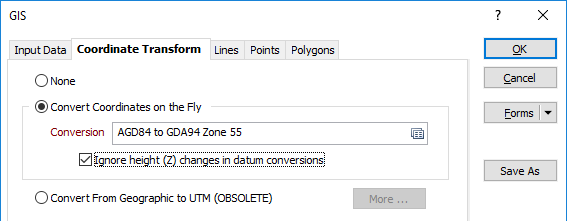Coordinate Transform
Modern geospatial data are defined in numerous coordinate systems from around the world, which can complicate the process of combining them into a single view. A typical example involves converting government data (in latitude/longitude coordinates) to the working coordinate system of your project; another is converting historic data on an old geodetic datum to a modern geocentric datum.
Micromine’s Coordinate System Conversion options support virtually any pair of coordinate systems. Most conversions are between recognised coordinate systems, and Micromine uses the EPSG (European Petroleum Survey Group) database to supply the parameters for well over 5000 coordinate systems and their conversions. Micromine also supports the high-precision distortion grid methods (also known as shift or difference grids) required by modern datums.
To convert between coordinate systems, select the Coordinate Transform tab.
The process takes place in two stages:
- Define the conversion by choosing the origin and destination coordinate systems. This happens only once, and typically takes just a few seconds.
- Use it to convert your coordinates.
Once the conversion is defined, you can convert DATA (and related) files, wireframes, interactively via the relevant dialogs. This setup-once, use-many-times philosophy hides the conversion details and ensures that you always use the same parameters every time you run that conversion.

Convert Coordinates on the Fly
Select the Convert Coordinates on the Fly check box to convert between coordinate systems prior to displaying the data.
Conversion
Select, or create a new, coordinate conversion form set. See: Setup
Ignore height (Z) changes in datum conversions
Height (Z) coordinates are optional inputs to the process. Select this option to limit the transformation process to the X and Y coordinate fields.
Convert From Geographic to UTM
To perform a geographic to UTM grid transformation, click on the More button to set the angle units and define the Spheroid that will be used for the transformation.